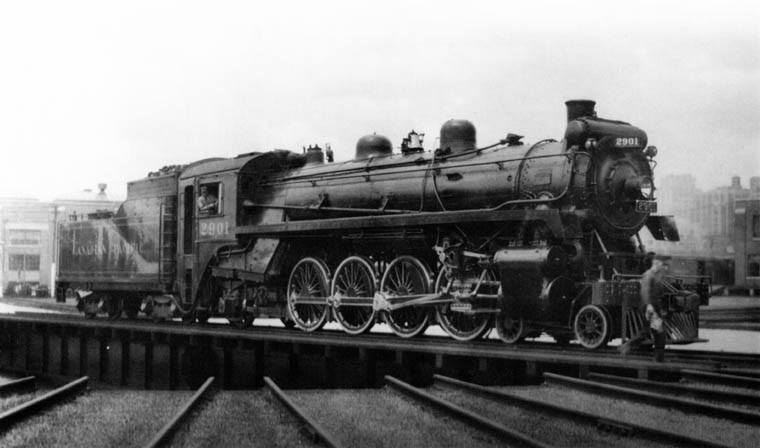
Paterson-George Collection
Posing proudly with typical John Street polish, No. 2901,
class I1a 4-8-2 stands for her portrait in the summer of 1932. This
was in the days when good unobstructed photos could be shot of locomotives
on the turntable. In later years heavy timber handrails were constructed
along the sides after someone had fallen into the pit. The 2900 - 2901
were the only 4-8-2 Mountains on the CPR system. These two engines
were built at Angus during July and August, 1914. They were built for
passenger service and spent their lives on the Eastern Lines. The twins
spent a big part of their lives at Toronto, where, in their early years
they were assigned to the north end and were housed at West Toronto.
They were not allowed to run downtown because of certain weight restrictions
in effect at that time. They were uncoupled at West Toronto and a lighter
engine hauled the train to the Union Station. In the late 1920s and
1930s they were assigned to John Street.
In 1933, when the passenger pool train system was introduced, the CPR
was allotted the Toronto-Ottawa service exclusively and the 2900s were
assigned to this run. On April 2,1933 Train No. 34 left the Toronto
Union Station at 11:35 p.m. on its first trip behind No. 2901. The train
consisted of mail car 3759, baggage car 4404, day coach 5115, sleeping
cars, Port Elgin, Port Moody, Nobleford, Nelson, North Bay, Southhampton,
Saugeen, Vancouver, and observation car Mount Gordon. On No. 33 out
of Ottawa on the same night at 11:35 p.m. the train consisted of No.
2900, mail car 3764, baggage car 4362, first class coach 5166, sleeping
cars, Port Rowan, Sovereign, Viceroy, Salamanca, and observation car
Mount Rodney. The engines ran through changing engine crews at Havelock
and Smith's Falls.
Eventually these engines were transferred to the New Brunswick District
where they ended up their careers. The 2900 was scrapped at Angus on
November 30,1945 and 2901 in October, 1944. The original classification
for these engines was H1 a but when the 4-6-4 Hudsons came out in 1929,
it was changed to I1a. The reason for the change was because all Pacific
4-6-2s were classified in the G slot and the Hudson 4-6-4s, being
a refinement of the 4-6-2, should be classed in the next alphabet group.
As with most of the CPR's large power of this period, the 2900s saw
a rebuilding at Angus; the 2900 being dealt with during November, 1924
and 2901 in December, 1926. This involved the rebuilding of the valve
gear, the cylinders and the frame. Later, they received Elesco feedwater
heaters and water pumps. These engines were never equipped with stokers,
remaining as hand bombers until the end of their days.
